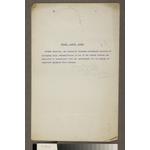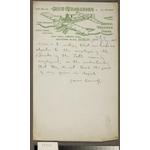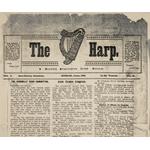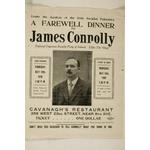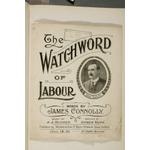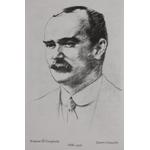The Seven Signatories of the Proclamation
James Connolly, Vice-President of the Provisional Government of the Irish Republic
As Commandant General of the Dublin Brigade of the Army of the Irish Republic, he directed the military action.
James Connolly (1868-1916) was born at 107 Cowgate, Edinburgh, the son of Irish Catholic emigrants, John Connolly, a carter, and his wife Mary McGinn. The family lived in extreme poverty. James went to work at the age of eleven and joined the British Army at fourteen, serving in Ireland for seven years. Returning to Edinburgh in 1890 he became actively involved in socialist politics. He was self-taught, reading voraciously in history, politics, economics and socialism. He came to Dublin in 1896 where he founded the Irish Socialist Republican Party and published the newspaper The Workers’ Republic. He opposed Home Rule as middle class, capitalist, and unlikely to promote social reform.
In 1903 Connolly spent three months in the United States on a lecture tour; the following year he brought his family to live with him in New York, where he was active in Irish nationalist and socialist circles. He was a co- founder of the syndicalist Industrial Workers of the World (‘the Wobblies’) becoming their New York organiser. He also became a national organizer for the Socialist Party of America. In 1907 Connolly founded the Irish Socialist Federation and edited its journal The Harp which he set up in 1908. While in America he wrote some of his best-known works, including Labour in Irish History, which greatly influenced the thinking of Patrick Pearse, and his famous polemic, Labour, Nationality and Religion, both of which were published in Dublin in 1910.
Returning to Ireland in 1910, Connolly worked as Belfast organiser for the Irish Transport and General Workers’ Union which had been founded by Jim Larkin. Moving to Dublin, he was second-in-command to Larkin during the 1913 lock-out. When Larkin went to the United States in 1914, Connolly succeeded him as head of the ITGWU and editor of the Irish Worker. He also became commandant of the Irish Citizen Army, which had been formed to protect workers during the 1913 lock-out.
Connolly was appalled at the outbreak of the First World War in August 1914 and launched an anti-recruitment drive. He came to regard revolution as the only political option and in January 1916 reached agreement with the leadership of the Irish Republican Brotherhood for a joint insurrection involving the Irish Volunteers and the ICA, whereupon he was co-opted to the IRB Military Council involved with preparations for the Rising. Together with MacDiarmada and Plunkett, he had a leading role in the final preparations. He was also, of course, responsible for providing the ICA contingent of 200-250 men who turned out on the day. He contributed to the content of the Proclamation of the Irish Republic drafted by Pearse, particularly the socialist, feminist and egalitarian elements. He became vice-president of the Provisional Government.
During the Rising Connolly was located in the General Post Office with most of the other members of the Provisional Government. As commandant general of the Dublin division of the army of the Irish Republic, he directed military operations. On the Thursday of Easter Week he suffered a serious wound to his ankle outside the GPO, but remained in charge. Following the surrender, he was tried by court-martial. Although seriously injured he was executed by firing squad in Kilmainham Jail on 12 May, he and Seán MacDiarmada being the last of those to be executed. He was survived by his wife Lillie Reynolds and children, including his son Rory, who served with him in the GPO.









